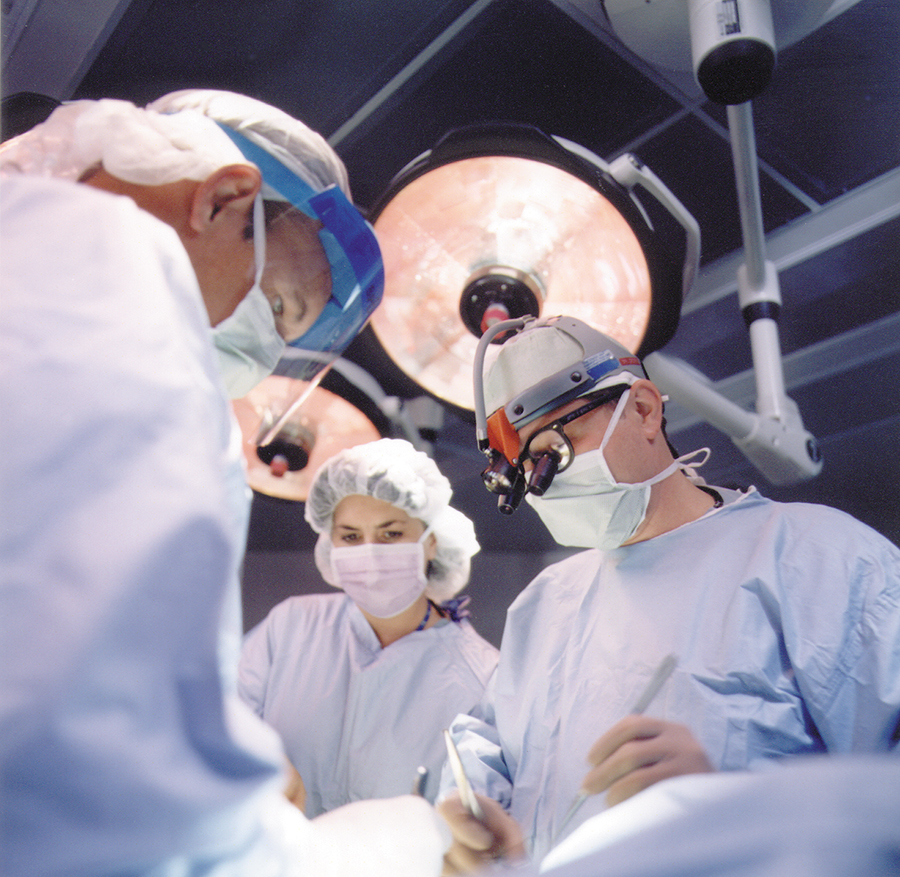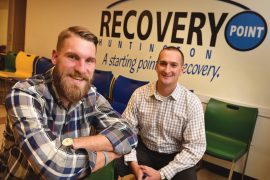By Tim Massey, Susan Hahn and Jean Harbett
HQ 24 | WINTER 1999
St. Mary’s and Cabell Huntington
Even the casual visitor to Huntington can see that the city’s two major hospitals have physically grown closer together over the past 10 years. What the most informed resident might not know is that St. Mary’s Hospital and Cabell Huntington Hospital could not have become elite medical facilities without the uncommon teamwork of their chief executive officers. J. Thomas Jones of St. Mary’s and W. Don Smith of Cabell Huntington say they are proud of what their hospitals have been able to achieve through a coordinated effort that has been extremely beneficial to the Huntington medical community.
“I think the one thing I’m most proud of since I came here is the collaboration between St. Mary’s and Cabell Huntington Hospitals,” says Jones who started his ninth year as St. Mary’s top administrator in February.
“We’ve done the MRI Center, the Joint Trauma Center, the physician’s hospital organization for managed care contracting and the Huntington Medical Community Foundation. And, now we have Genesis.”
Genesis is a joint venture in which Huntington’s two largest hospitals have affiliated with Pleasant Valley Hospital of Point Pleasant. The partnership makes Genesis the second-largest hospital corporation in West Virginia. Only Charleston Area Medical Center is larger.
Smith, now in his 12th year at Cabell Huntington, says Genesis will allow the hospitals to consider doing projects that they could not afford to do as separate entities. The partnership, he says, will help Huntington maintain its status as a regional medical center and compete against areas like Charleston, Lexington, Ky. and Columbus, Ohio.
“We (Cabell Huntington and St. Mary’s) could not continue to grow at the pace we were,” Smith says. “Health care is too expensive for you to be all things to all people. It’s time to partner with someone.

“We believe we can deliver health care more efficiently and more cost-effectively by working together. We can combine our costs on things like advertising and marketing. Genesis hasn’t made a big splash yet. But, it’s there and it’s working. Community leaders who are active in all three hospitals are working together on projects that will be mutually beneficial to all of us.”
Both Jones and Smith say a logical move would be to add financially troubled Logan General Hospital into Genesis.
“Traditionally, hospitals in Huntington have served people from Southern West Virginia,” Smith says. “I think Logan General would be a natural fit in Genesis. We’ll just have to wait to see what happens.”
To this point, St. Mary’s and Cabell Huntington have experienced unprecedented growth as hospitals in the 1980s and 1990s to meet the ever-changing demands for medical care. Founded by Pallotine Missionary Sisters in 1924, St. Mary’s has grown from a renovated prep school in East Huntington into West Virginia’s second-largest hospital. With the opening of its $17 million, 74,000-square-foot Outpatient Center on July 2, 1997, the Catholic not-for-profit hospital has more than one million square feet of space. It is Cabell County’s largest private employer with 2,000 full and part-time employees, a $100 million a year budget and a $60 million annual payroll.
“I always say we’re the largest single hospital in West Virginia,” says Jones, a virtual human computer of medical statistics. “Charleston Area Medical Center is actually five hospitals that have merged into one.”
He says St. Mary’s has had to expand to meet new demands in health care delivery. “Things have changed dramatically in the years since I came here,” Jones says. “There is a greater emphasis on outpatient care. Things are being done now that weren’t even being considered back then. The number of open heart surgeries have more than doubled.”
Angioplasties weren’t even being done back then. We have more specialists – orthopedics, neurosurgeons, radiologists. We didn’t have MRI. Ten percent of the revenue was outpatient when I came. Now it’s 30 percent. That tells you what has changed.”
Through a coordinated effort with Cabell Huntington Hospital, St. Mary’s has specialized in open-heart surgery and cancer treatment. Its Heart Center performs more than 550 open-heart surgeries a year.
The hospital is affiliated with Duke Comprehensive Cancer Center, a partnership that has made St. Mary’s a regional center for cancer treatment.
Meanwhile, Cabell Huntington Hospital has expanded greatly since 1987 when it was allowed to change its status from a public facility to a private non-profit hospital. The change allowed the hospital to diversify its operation and become more competitive. As part of its agreement with the Cabell County Commission and the city of Huntington, Cabell Huntington established a $3 million account to help Marshall University build a new medical center. That seed money grew to $32 million by the time the Marshall Medical Center and Robert C. Byrd Center for Rural Health were completed in 1998.

“The switch in affiliation was a key to our growth as a hospital,” Smith says. “We could not have completed our partnership with Marshall University if we had remained a public hospital.
“It was an important step for us to keep up with the competition.”
With Smith at the helm, the hospital has undergone more than $60 million in renovations and expansion. In addition to the 185,000 square foot Marshall facility, the hospital has built a new surgical wing and renovated its obstetrical floor and pediatric unit.
“I’m really proud of the new Marshall Medical Center,” Smith says. “Think of bringing Marshall and the hospital together and pooling our money and paying for a $32 million facility without incurring a dime of public debt.
“It allows the medical school to become a premier school. Instead of being a recruiting burden, the facility has become a recruiting strength. It has helped the university and the hospital bring in some of the finest physicians in the country.”
Cabell Huntington also just built a new helicopter landing pad near the emergency room entrance to make landings much safer, Smith says.
“We’re the obstetrics hospital, the burn hospital and we’re the pediatrics hospital,” he says. “We deliver 2,500 babies a year, second highest in West Virginia. Only CAMC has more. Patients come here from 40 counties in three states.”
With the additions, Cabell Huntington has more than 600,000 square feet of space under roof. It employs about 1,600 people, brings in about $160 million in gross revenues and has an annual payroll of $65 million.
The two hospital executives say the teamwork has further established Huntington as a medical center, a status the city has enjoyed for a number of years.
“Huntington was a medical center before I came here,” Jones says. “The railroad was here, so people came to Huntington for medical care. The roads were too bad for travel, so people rode the trains.”
Smith says Marshall’s School of Medicine has been the catalyst to help Huntington’s reputation as a health care center grow even more.
“Huntington is truly a medical crossroads,” he says. “The facilities, specialists and the medical school make Huntington a place where other communities send their most difficult patients.”
Dr. Charles H. McKown, dean of Marshall’s medical school and a practicing radiologist, says the hospitals’ team concept is not always smooth.
“I compare the two hospitals to a basketball team,” Dr. McKown says. “They might elbow each other in practice, but when it’s game time, they play together.
“That is why the hospitals here are as good as you’ll find anywhere in the country for a city this size.”
He points to the Joint Trauma Unit as a great example of teamwork. The two hospitals operate the centers on alternating days. On even days, trauma patients are transported to St. Mary’s. On odd days, they go to Cabell Huntington.
“Huntington was the first city in the country to have a joint operation,” McKown says. “That was in 1988. Now, a lot of other places around the country are copying us.”
The reason for the cooperative effort was to save money, Smith says. “Trauma is an expensive proposition,” he says. “Both hospitals could not afford to have trauma centers operating around the clock. It would be a terrible drain on our resources. The joint operation works like a jewel.
“Dr. Charles “Skip” Turner, director of Ultimate Health Care which recently signed a partnership agreement with the Pallotine Health Services (St. Mary’s parent corporation), says local physicians have played a role in the cooperative growth of the two hospitals.
“Most physicians in town work at both hospitals,” Dr. Turner says. “It’s been that way for years. That isn’t to say that the hospitals haven’t competed against each other. They have, but it’s been a healthy competition.
“I attribute a lot of the teamwork to two really good administrators. They realize that there are limited health care resources, and growth has to be coordinated. The real winner in the long run is the public.”
Smith and Jones say there will be even more cooperation between the hospitals in the future. The avenue for the joint ventures is Genesis.
“I hate to repeat our slogan, but Genesis makes sense,” Smith says. “Medical care is very important to this community. It provides thousands of jobs, and millions of dollars in revenue. As time goes on you will read more about Genesis.”
Jones echoes Smith’s sentiments.
“There is strength in numbers,” he says. “We’re looking at a number of projects we can do jointly that we could not do individually. We’ve discussed an occupational medicine center and a diabetes medicine center. There will be others.
“Genesis gives us the ability to do things proficiently. I believe it will be a real plus to the community.”

Marshall University Medical Center
To stand in the neonatal intensive care unit (NICU) at Cabell Huntington Hospital, to view the frailty of life, to see the hope of ordinary people trying to overcome extraordinary circumstances, is to delve into the core of health care. The NICU at Cabell is the largest in the state, it provides state-of-the-art specialized health care and it is entirely staffed by the Department of Pediatrics at the Marshall University School of Medicine. Since its inception, the medical school has been rooted in the medical community, and its contributions are as diverse as the needs of the community.
Dr. Joseph W. Werthammer, chairman of the MU School of Medicine Department of Pediatrics notes that when he came to Huntington 20 years ago, children with complicated problems were sent to medical centers in larger cities like Columbus or Cincinnati. That is no longer the case. Over the years the pediatrics department has grown with the medical school and the community.
The medical school Department of Pediatrics is made up of 22 board-certified pediatricians, 11 of which also are fellowship-trained in a subspecialty area, a distinction that requires an additional two years of training after the completion of a three or four year residency. All of the specialty areas offered in pediatrics are unique to this region, enabling children who have special needs to receive the medical care they need in Huntington. The NICU is headed by the only neonatologist in the area. The pediatric intensive care unit at Cabell, which provides care for critically ill children, is staffed by the region’s only pediatric intensivists, who also are school of medicine faculty members.
The pediatrics department continues to expand and bring new expertise into the area. In the past couple of years, the department has expanded to provide additional services for children with developmental-related problems. Now handicapped children can have all the appropriate support services under one roof through the Helping Hands Development Center. The center is staffed by a developmental sub-specialist and a physical medicine sub-specialist, each of whom provides expertise otherwise unavailable in the area.
Dr. Charles H. McKown, Jr., vice president and dean of the Marshall University School of Medicine, explains that the educational process to become a medical doctor necessitates having highly-trained physicians on the faculty, and the community benefits from that expertise at all levels – primary, secondary and tertiary.
“The medical school itself has raised the threshold of the quality of medicine practiced here,” McKown says. He emphasizes that Huntington has always had outstanding physicians practicing in the community, many of whom help in the teaching and training of students.
The faculty of the school of medicine is comprised of 135 physicians. Each of these physicians practices medicine through University Physicians & Surgeons, the practice arm of the medical school. With the opening of the new Marshall University Medical Center at Cabell Huntington Hospital, the majority of the school’s outpatient clinics were consolidated in the University Physicians Center, the heart of the new medical center.
The physicians center provides access to the most diverse medical services available in the region under one roof. It has nearly 100 examination rooms outfitted with the most advanced, state-of-the-art diagnostic equipment for Internal Medicine, Family Practice, Surgery, Cardiovascular Services, Pediatrics, Obstetrics/Gynecology, and Psychiatry & Behavioral Medicine.
“The medical center has allowed us to do the work of the medical school infinitely better,” says McKown. “It is the first time that we have had the opportunity to work under one roof as an integrated practice and helps patients tremendously.”
While the medical center is a partnership between the medical school and Cabell Huntington Hospital, it works closely with all three acute care hospitals in the Huntington area – Cabell, St. Mary’s and the Veterans Affairs Medical Center. “The quality of these facilities is superior to most of comparable size in the United States,” McKown says.
“We feel that our teaching and clinical presence has been a major part of the catalyst generating the energy to achieve the patient care excellence these hospitals demonstrate on a daily basis.”
As with pediatrics, each department of the medical school provides unique services that complement and strengthen the medical community.
The Department of Surgery consists of 11 general surgeons, four of whom are vascular surgeons. The department also has two fellowship-trained, board-certified plastic surgeons, one is also certified in hand surgery; and a fellowship-trained, board-certified pediatric surgeon.
The surgeons provide all varieties of general and vascular surgery, and provide the majority of care for trauma patients in the area. Dr. David A. Denning, the chairman of the surgery department, does most of the complicated pancreatic surgery in the region. The surgery department also has a free-standing breast center, the University Physicians & Surgeons Breast Care Center. It provides a variety of diagnostic and therapeutic breast care including mammograms and ultrasound testing, as well as the stereotactic core needle biopsy, a less invasive procedure for women with abnormal mammograms.
The Department of Cardiovascular Services is staffed by five cardiologists and three thoracic and cardiovascular surgeons, including one of only two pediatric cardiac surgeons in the state. The cardiologists provide interventional procedures such as angioplasty and athrectomy; and other cardiology evaluation and treatment including heart catheterizations, echocardiography and other related procedures when necessary. The surgeons also provide thoracic surgery and coronary bypass surgery, heart valve replacement and surgery to correct congenital heart problems.
The Department of Internal Medicine provides medical care for adult patients. It is the largest department, with approximately 30 physicians representing 10 specialty areas. It also offers unique services such as the only infectious disease specialists in the region. The medical school provides a major amount of care for people with HIV, working with the Cabell County Health Department in a cooperative venture to run their STD and TB clinics.
The internal medicine department also has a specialized geriatric staff that organizes and runs the Hanshaw Geriatrics Center, the first geriatric assessment center in the state.
The Department of Obstetrics and Gynecology offers total care for women. In addition to the seven general OB/GYN physicians, the department has the region’s only board-certified gynecologic oncologist, a sub-specialist in women’s reproductive cancers. The area’s only perinatologist, a department specialist in maternal-fetal medicine, directs the High-Risk Obstetrics Care unit at Cabell Huntington. Rounding out the department are a fertility specialist and a surgeon who specializes in pelvic reconstructive surgery.
The Department of Psychiatry & Behavioral Medicine is comprised of seven full-time psychiatrists and six psychologists who provide clinical care to the community in areas such as anxiety, depression, substance abuse, eating disorders and other behavioral problems. The department supports the behavioral medicine programs at River Park Hospital and Huntington State Hospital, and provides outreach services for other community groups and programs.
Not only does the Marshall University School of Medicine support the medical community in Huntington, it also has excelled in the development of innovative support programs for delivery of medical services to rural populations. These programs are aimed at reducing the isolation of rural health care providers and their patients through support programs and the use of telecommunications technologies.
Family and Community Health developed and implemented the nation’s first rural family practice training program for residents with special approval from the American Board of Family Practice. This innovative program allows six residents to train in rural health settings, tailoring their experience to the type of community they plan to practice in.
According to McKown, much of the credit for the realization of the new medical center can be attributed to the leadership of Marshall University President J. Wade Gilley. “Dr. Gilley has set the university upon a progressive course that has transformed Marshall into a pacesetter and this medical center fits right into that mold,” McKown said.
In addition to the clinical practice, each department of the medical school has a responsibility to provide quality education to the students. Teaching physicians are responsible for staying on top of developing scientific practices and research, emerging technology and changing health care needs.
The school of medicine has an additional 130 physicians in its residency programs and they are considered an asset in providing care.
It is a testament to the capabilities of the faculty and students that Marshall medical students rank in the top half of all medical students in the United States – including those from Harvard, Johns Hopkins, Duke and Stanford – on Step 2 of the United States Medical Licensing Examination, a key test required before any student can become a licensed physician in the United States.
The Marshall University School of Medicine is an integral component of the medical community. Its direct and indirect contributions to health care are multidimensional. Based on two previous studies, the annual direct economic impact of the medical school is expected to exceed $200 million, an increase of more than $51 million since the 1995-96 fiscal year.

VA Medical Center
The Veterans Affairs Medical Center’s pristine setting high among the hills surrounding Huntington is an apt home for the progressive, technologically-advanced facility that serves the community. “In many ways the VA has been the best kept secret for years,” David N. Pennington, director of the VA Medical Center boasts.
Within the past 10 years, $61 million has been invested in upgrading the VA facility in Huntington. The Robert C. Byrd Clinical Addition, which opened in 1993, greatly expanded surgery, radiology, laboratory, cardiology, nuclear medicine, rehabilitation medicine and intensive care services. The new $10 million research addition, which was completed early last year, houses state-of-the-art research laboratories and support facilities.
These buildings are contiguous with the Coon Medical Education Building, a physical as well as philosophical connection that reflects the relationship between the VA Medical Center and the Marshall University School of Medicine. The medical school was created through the VA Health Manpower Training Act in 1973 and has been affiliated with the VA since its inception. The two institutions have built a strong partnership over the years. Pennington notes that the majority of the faculty at Marshall’s medical school are either part-time at the VA or on the teaching faculty.
Pennington views the affiliation with the school of medicine as a plus for both Marshall and the VA. “It means bright young people challenging senior physicians, keeping them sharp and on their toes,” Pennington says. “It means better patient care for us, better physicians for everybody in the community.”
The VA Medical Center and its satellite centers in Prestonsburg, Kentucky and Charleston, West Virginia serve approximately 20,000 people in the region, with more than 140,000 outpatient visits. The medical center, a fully accredited 80-bed medical and surgical care facility, had more than 3,800 admissions last year.
As with many health programs, primary care is the starting point for integrated care. Primary care at the VA medical center includes emergency room treatment, walk-ins, medical specialty clinics and telephone care. The staff is continually looking for ways to make the care more accessible to veterans. Each patient has a physician who coordinates the patient’s care.
“The new VA is serving more veterans than it has ever served in its history,” Pennington says. The mix of veterans that are being cared for at the VA is changing. While the number of WWII veterans is declining, the number of veterans of Korea, Viet-Nam and Gulf wars, as well as veterans of peacetime activities, are using the medical center more than ever. Women’s programs have been added to provide care for that growing segment of veterans.
One of the most exciting developments at the VA Medical Center was the implementation last year of the network-wide Computerized Patient Record System (CPRS). The system organizes all the information relevant to the patient’s care into a structured integrated “filing cabinet” that provides real time information for each patient. The system is secure, and users change their code every 90 days.
Physicians and other health care providers have immediate electronic access to a comprehensive history of the patient, an invaluable tool for delivery of high quality health care. The user-friendly system is set-up like regular files with tabs showing the various “folders” that are pertinent to the patient including a history or summary of problems, medications, orders, notes, consultations, laboratory tests and results and reports.
The patient’s record can reflect any point in time during the patient’s care. Many of the “charts” can be shown simultaneously on the PC screen. Information can be viewed in charts or graphs to make analysis easier. The system provides a legible time-stamped, dated patient record and reduces redundant or conflicting information. Most importantly, it increases the continuity of care by improving communication among health care providers.
All of the organizational improvements allow the VA Medical Center to provide better care for its patients and that is the bottom line according to Pennington.
“I can’t communicate enough about the special people we serve.” Pennington thinks the current attention on WWII in movies such as “Saving Private Ryan” and “The Thin Red Line,” and the bestseller The Greatest Generation by Tom Brokaw are a fitting tribute to the VA patients.
“For us, the people that we see everyday are the quiet heroes whose stories are not going to be told. They are part of a tremendous generation that has made unbelievable contributions to this country.”





